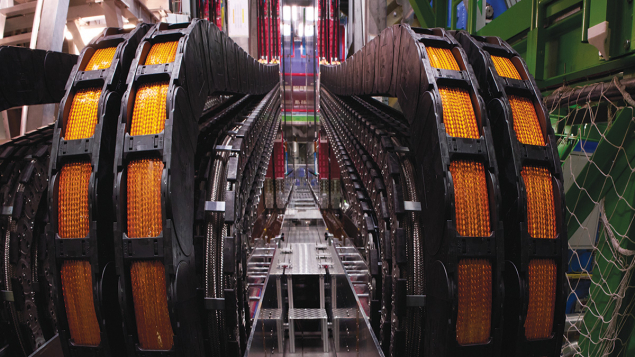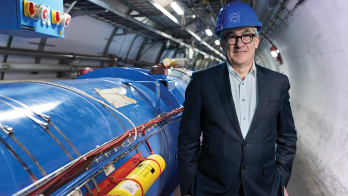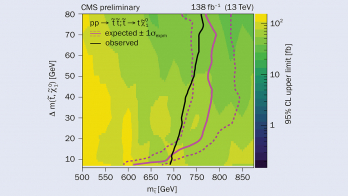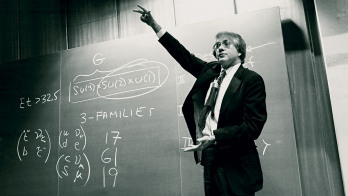
The Implications of LHCb measurements and future prospects workshop drew together more than 200 theorists and experimentalists from across the world to CERN from 23 to 25 October 2024. Patrick Koppenburg (Nikhef) began the meeting by looking back 10 years, when three and four sigma anomalies abounded: the inclusive/exclusive puzzles; the illuminatingly named P5′ observable; and the lepton-universality ratios for rare B decays. While LHCb measurements have mostly eliminated the anomalies seen in the lepton-universality ratios, many of the other anomalies persist – most notably, the corresponding branching fractions for rare B-meson decays still appear to be suppressed significantly below Standard Model (SM) theory predictions. Sara Celani (Heidelberg) reinforced this picture with new results for Bs → φμ+μ– and Bs → φe+e–, showing the continued importance of new-physics searches in these modes.
Changing flavour
The discussion on rare B decays continued in the session on flavour-changing neutral-currents. With new lattice-QCD results pinning down short-distance local hadronic contributions, the discussion focused on understanding the long-distance contributions arising from hadronic resonances and charm rescattering. Arianna Tinari (Zurich) and Martin Hoferichter (Bern) judged the latter not to be dramatic in magnitude. Lakshan Madhan (Cambridge) presented a new amplitude analysis in which the long and short-distance contributions are separated via the kinematic dependence of the decay amplitudes. New theoretical analyses of the nonlocal form factors for B → K(*)μ+μ– and B → K(*)e+e– were representative of the workshop as a whole: truly the bee’s knees.
Another challenge to accurate theory predictions for rare decays, the widths of vector final states, snuck its way into the flavour-changing charged-currents session, where Luka Leskovec (Ljubljana) presented a comprehensive overview of lattice methods for decays to resonances. Leskovec’s optimistic outlook for semileptonic decays with two mesons in the final state stood in contrast to prospects for applying lattice methods to D-D mixing: such studies are currently limited to the SU(3)-flavour symmetric point of equal light-quark masses, explained Felix Erben (CERN), though he offered a glimmer of hope in the form of spectral reconstruction methods currently under development.
LHCb’s beauty and charm physics programme reported substantial progress. Novel techniques have been implemented in the most recent CP-violation studies, potentially leading to an impressive uncertainty of just 1° in future measurements of the CKM angle gamma. LHCb has recently placed a special emphasis on beauty and charm baryons, where the experiment offers unique capabilities to perform many interesting measurements ranging from CP violation to searches for very rare decays and their form factors. Going from three quarks to four and five, the spectroscopy session illustrated the rich and complex debate around tetraquark and pentaquark states with a big open discussion on the underlying structure of the 20 or so discovered at LHCb: which are bound states of quarks and which are simply meson molecules? (CERN Courier November/December 2024 p26 and p33.)
LHCb’s ability to do unique physics was further highlighted in the QCD, electroweak (EW) and exotica session, where the collaboration has shown the most recent publicly available measurement of the weak-mixing angle in conjunction with W/Z-boson production cross-sections and other EW observables. LHCb have put an emphasis on combined QCD + QED and effective-field-theory calculations, and the interplay between EW precision observables and new-physics effects in couplings to the third generation. By studying phase space inaccessible to any other experiment, a study of hypothetical dark photons decaying to electrons showed the LHCb experiment to be a unique environment for direct searches for long-lived and low-mass particles.
Attendees left the workshop with a fresh perspective
Parallel to Implications 2024, the inaugural LHCb Open Data and Ntuple Wizard Workshop, took place on 22 October as a satellite event, providing theorists and phenomenologists with a first look at a novel software application for on-demand access to custom ntuples from the experiment’s open data. The LHCb Ntupling Service will offer a step-by-step wizard for requesting custom ntuples and a dashboard to monitor the status of requests, communicate with the LHCb open data team and retrieve data. The beta version was released at the workshop in advance of the anticipated public release of the application in 2025, which promises open access to LHCb’s Run 2 dataset for the first time.
A recurring satellite event features lectures by theorists on topics following LHCb’s scientific output. This year, Simon Kuberski (CERN) and Saša Prelovšek (Ljubljana) took the audience on a guided tour through lattice QCD and spectroscopy.
With LHCb’s integrated luminosity in 2024 exceeding all previous years combined, excitement was heightened. Attendees left the workshop with a fresh perspective on how to approach the challenges faced by our community.





